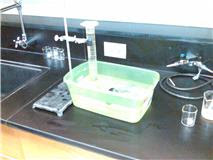In our Biology class my lab partner and I studied the decrease in ML (milliliters) of water from mixing H2O2 or hydrogen peroxide together with Yeast. Our set up consisted of a small tub, a graduated cylinder containing of 100 ML of water, a holder for the cylinder, a small tube to connect another cylinder to the graduated cylinder, a syringe, H2O2, and yeast. First we submerged the graduated cylinder in the tub of water and flipped it to keep the water within it, we hooked it onto a stand to make it stay in place. Next we started with 1 ML of yeast and added it to 10 ML of hydrogen peroxide capped it and set the tubing into the graduated cylinder. For the course of 5 minutes we counted how far the water went down in the cylinder. The first trial it had gone down 42 ML, the second trial we put .75 ML of yeast and it had gone down only 33 ML in 5 minutes. We did the same test but changed the amount of yeast for each third was .50 ML and it had gone down 15 ML, then our fourth trial for .25 ML it had only gone down 12 ML in the allotted time of 5 minutes. Our project showed that the fewer enzymes in the concoction, that it will show that the yeast and H2O2 to react together and have fewer bubbles to rise and cause the water level to lower.
Here is a photo of our lab set up.
The level the water stood at after the five minutes had passed.


I like your overall post, but I think you are giving the wrong idea to your audience. You were not measuring how far down the water level moved. You were measuring how much gas was produced (the gas then pushed the water out of the cylinder). This would change the look of your graph and your wording in the blog.
ReplyDelete